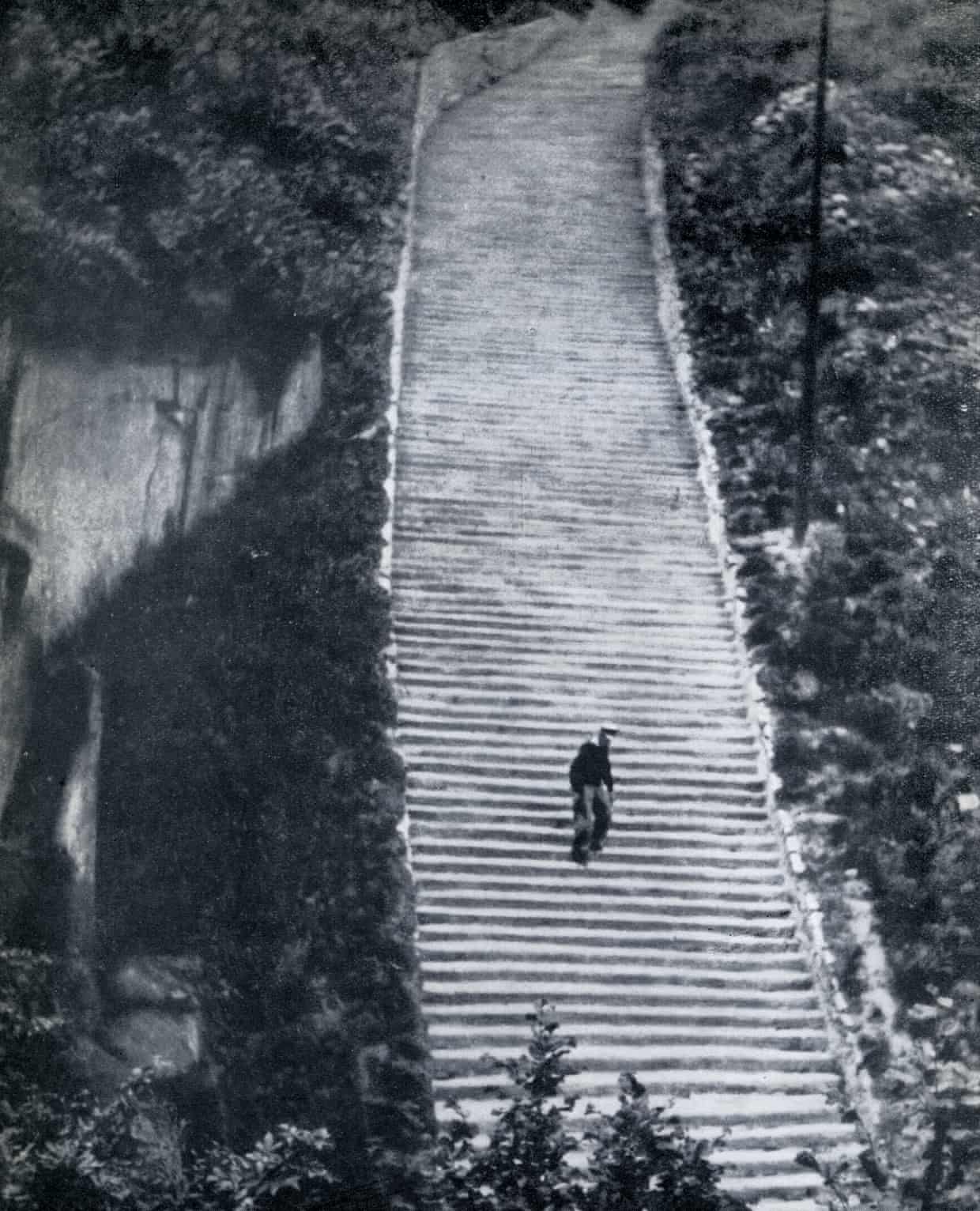I have no particular reason for making a copy of this Guardian link other than to remind myself and anyone who happens to read it of the depth of depravity to which human beings can sink.
About 7,500 Spanish Republicans who fled to France were deported to Mauthausen camp in Austria
Sam Jones in Madrid
@swajones
26 Jan 2023
When, on 5 May 1945, two tanks from the US army’s 11th Armored Division finally rolled into Mauthausen, one of the camp’s prisoners caught a glimpse of himself and his fellow inmates in their liberators’ faces.
“Before their eyes,” recalled Alfonso Maeso, “marched a dismal procession of men devastated by years of suffering, massing before them, some whispering, others sobbing inconsolably.”
 |
| The 186-step ‘staircase of death’ at Mauthausen. Photograph: Fototeca Storica Nazionale/Getty |
Mauthausen, which was built on a hill overlooking the Danube near the Austrian city of Linz, was the last Third Reich concentration camp to be liberated. Of the 190,000 people who passed through its gates – among them Jews, Gypsies, LGBTI people, Jehovah’s Witnesses, “asocials” and political opponents of nazism – about 90,000 were murdered or were worked, or starved, to death.
Less well known, until comparatively recently, is the fact that almost 5,000 of those who perished in the camp were Spanish Republicans who had been stripped of their nationality and deported from France. Eight decades later, an exhibition at Madrid’s Sefarad-Israel Centre is hoping to reflect the shared experiences of the 50,000 Jews and exiled Spaniards who endured the camp.
Their intertwined stories are told through memories, official documents and personal effects. Alongside these are first-hand accounts of death, and life, inside Mauthausen and its surrounding sub-camps
One of Mauthausen’s most notorious sites was its granite quarry and the 186-step “staircase of death” up which starving and exhausted prisoners were forced to march carrying 50kg (8st) rocks. [110 lb.]
Some prisoners – especially Dutch Jews – were simply pushed over the quarry cliff. Such murders were officially recorded as “suicide by jumping”, but the guards had another name for the victims: “parachutists”. Other inmates, starving and worked past the point of human endurance, threw their bodies against the electrified fences. Then there were the medical “experiments” to determine what kind of pain and paralysis resulted from injections to the heart, and to see how long people could live on gruel.
The exhibition also tells the story of the Greek Sephardic Jews whose centuries-old community in Thessaloniki came close to total destruction after the Nazis deported and murdered more than 90% of the city’s Jewish inhabitants, and of the Spanish civil war’s International Brigade volunteers who found themselves sent to Mauthausen.
The idea, according to the exhibition’s curator, historian Josep Calvet, is to provide the historical context that led to Mauthausen and explore how the camp became “an encounter between Jews and Republicans”.
Five hundred thousand Republican Spaniards fled to France in early 1939 after it became clear that Franco’s Nazi-backed nationalists were going to win the Spanish civil war, which had begun almost three years earlier with an attempted military coup against the elected government. About 60,000 Republican soldiers joined the French army, only to find themselves at the mercy of the Nazis and the Vichy regime after France fell in 1940.
Almost 10,000 Republicans were rounded up and deported from prison and prisoner-of-war camps, with about 7,500 of them ending up at Mauthausen. Declared “stateless” and forced to wear inverted blue triangles on their camp uniforms to denote their lack of a country, they found themselves alongside tens of thousands of Jews whose striped clothes bore a yellow Star of David.
The stitched shapes were not the only thing that separated the two groups, as the Spaniards soon realised. While Mauthausen’s Spanish prisoners were stateless slave labour, its Jewish prisoners, like those in other camps – and like the Sinti and Roma – were victims of genocide.
The Republican soldier Juan Romero, the last Spanish survivor of Mauthausen until his death a little over two years ago, was always haunted by the memory of a young Jewish girl he saw one day while collecting the clothes of the newly arrived for disinfection.
“A group arrived at the camp,” Romero recalled. “There were men, women, tiny children … They passed in front of us and a girl smiled at me … the poor little thing, in her ignorance, didn’t know she was going straight to the gas chamber. And that hurt me terribly … There are many nights when I still remember her.”
There are also examples of survival and defiance. Mauthausen’s prisoners included Simon Wiesenthal, who would go on to hunt down Nazis after the war and fight to ensure the Holocaust was never forgotten. Francesc Boix, a Spanish Republican soldier and photographer, used his camera skills to document camp life. His pictures and testimony were used at the war crime trials at Nuremberg and Dachau.
Perhaps the most poignant story of all is that of Siegfried Meir and Saturnino Navazo. Siegfried, a German Jewish boy who was just eight when his family was sent to Auschwitz – where his parents were murdered – was transferred to Mauthausen in January 1945. Assigned to the Spanish prisoners’ barracks, he was taken under the wing of Navazo, a Republican soldier and footballer. With Navazo’s help and protection, Siegfried managed to survive the camp. After the war, Navazo adopted Siegfried and the pair settled in France. Navazo died in 1986. Siegfried, who went on to find fame as a singer in France, eventually moved to Ibiza, where he died in 2020.
Calvet acknowledges that the exhibition has come a little late for those survivors who are no longer around to share their stories. “Until a few years ago, the story of the [Spanish] deportees had been completely forgotten,” says the curator. “Why? Because the great majority of these people didn’t come back to Spain. They settled in France and never came back. By the time Franco had died and democracy restored, a lot of them were already dead. That meant the memory of all this remained distant.”
That distance suited the Franco regime all too well as it sought to dissociate itself from Hitler and Mussolini and cosy up to the victorious allies after the end of the war, says the journalist and historian Carlos Hernández de Miguel, the author of The Last Spaniards of Mauthausen.
That responsibility, he adds, led the Franco regime to bury the story of Mauthausen for almost four decades. “We know, 100%, that if Hitler sent them to Nazi camps it was after discussing it with the Franco regime – and very probably after receiving instructions from the regime.
“The true reality of these 9,000-plus Spanish men and women who passed through Nazi camps didn’t make it into the history books or into school textbooks. Let’s hope that this exhibition can go some way to paying this debt to the past we have as a country.”
The sentiment is shared by the Spanish government, which has organised the exhibition in partnership with Madrid’s Sefarad-Israel Centre and with the support of the German and Polish embassies and the Austrian government’s cultural forum.
During the course of his research in Catalonia last year, Calvet was surprised to discover that some families still had no idea their uncles or grandfathers had been in Mauthausen. “This needs to be told so we can look at the mistakes of the past and make sure they don’t happen again,” says the curator. “Memories that don’t help us look at the past and stop ourselves repeating it are not memories.”

